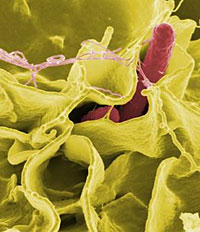Maintaining good gut bacteria in layers cuts risk of positive salmonella tests

Maintaining good gut bacteria and having on-belt litter drying systems are key factors in avoiding positive salmonella test results, says an expert.
This month saw new salmonella rules come into force which prohibit the sale of fresh eggs from flocks infected with either Salmonella enteritidis or S typhimurium. Instead, eggs must be heat treated or flocks slaughtered and replaced.
Kiotechagil’s chief technical officer Murray Hyden says: “The most effective control mechanism is to ensure that feed and water quality is high and promotes a healthy gut microflora.”
He points to the Code of Practice, which states: “Ingredients known to be at a high risk of salmonella contamination such as cereals and oilseeds stored in flat stores or open bins should be avoided where possible. Also, consider treating protein, cereal ingredients and whole grain feed with aldehyde/acid mixtures.
“And, after manufacture, feed must also be transported carefully to prevent post-processing contamination.”
Mr Hyden also urged poultry producers to take all necessary actions including, where necessary, incorporating acid products in layers’ rations, as this will greatly reduce the risk of salmonella positives from horizontal transmission or direct faecal contact with eggs.
“Certain products, such as Salkil, have been specially developed to optimise gut function, especially in layers and breeders where the high calcium content of rations can result in a higher gut pH dominated by potential enteropathogens.”
Enteropathogens, such as salmonella, erode the villi in the gut resulting in poor nutrient and water uptake. Feeding the acid leads to the rapid multiplication of acidophilic bacteria such as the lactobacilli, which directly reduce salmonella numbers and reduce intestinal pH.
A reduced hindgut pH supports the cellulose digesters that produce butyric acid, he said.
Butyric acid is an essential nutrient to optimise villus health and contributes directly to improved nutrient and water uptake. The result is a healthy, drier litter, which not only contains fewer enteropathogens, but also has a lower water activity.
He highlighted a recent report in the Journal of Epidemiology and Infection which found that cage-housing systems in the UK which have on-belt manure drying had a lower prevalence of salmonella infection than conventional installations.
The report records that on-belt manure drying is more successful because it allows the litter to dry faster and attain much lower levels of water activity. A low water activity, below the threshold of survival for salmonella, will initially prevent multiplication and ultimately cause the death of the pathogens.
